Russian GPS-Jamming Systems Return to Ukraine
After a year out of public view, the R-330Zh made a massive return in 2019
Russian GPS-Jamming Systems Return to Ukraine

BANNER: (Source: @Michael1Sheldon/DFRLab)
After a year of silence, the Organization for Security Cooperation in Europe’s Special Monitoring Mission to Ukraine (OSCE SMM) reported a sharp increase in R-330Zh “Zhitel” GPS jamming activity in eastern Ukraine in 2019.
The OSCE SMM has reported a recent uptick in drone losses in the Donbas region in eastern Ukraine attributed to GPS jamming, which falls within the R-330Zh’s core capabilities and thus pointing to their presence as a likely culprit. The cellular and satellite communications jamming system is only operated by the armed forces of the Russian Federation and has not been recorded this extensively since 2015, so an uptick would also indicate an increase in Russian electronic warfare (EW) activity in the region.
While OSCE SMM monitors documented the system’s presence in eastern Ukraine from the ground, Ukrainian armed forces were able to record the system from the air by means of their improved commercial and military drone capabilities. Despite the R-330Zh’s supposed anti-unmanned aerial vehicles (UAV) capabilities, Ukrainian UAVs were able to direct artillery fire against it.
Along with the RB-341 “Leer-3,” the R-330Zh is one of the most prolific Russian EW systems operating in eastern Ukraine. The below graphic from the Ukrainian Ministry of Defense (MoD) shows the omnipresence of Russian EW systems in eastern Ukraine; several independent sources (OSCE, satellite imagery, etc.) noted the R-330Zh at many of these locations.

2019 Sightings
On February 4, 2019, the OSCE SMM to Ukraine reported for the first time in over a year that a R-330Zh had been spotted in eastern Ukraine. The system had been recorded on February 3 while entering a compound in the city of Luhansk. The system was sighted a day later at a training facility near the village of Khoroshe, approximately 36 km west of Luhansk.
The OSCE SMM next reported spotting an R-330Zh near Yuzhna-Lomuvatka, about 60 km west of Luhansk, on March 16. This report also alleged that the R-330Zh was spotted alongside a Tirada-2 satellite jamming vehicle, for which no official photographs have ever been released, thus making it hard to confirm. The Ukrainian Mission to the OSCE and UN in Vienna would later confirm this sighting in a tweet with drone imagery also taken on March 16 that showed similar systems in the nearby town of Yuzhna-Lomuvatka.
The OSCE SMM subsequently reported seeing an R-330Zh on March 27 along with another “undetermined” EW system near the town of Brianka, approximately 46 km west of Luhansk and 15 km northeast of Yuzhna-Lomuvatka.
On March 30, Facebook user Anatoly Stefan Shtirlits, a well-known provider of combat footage from the Donbas region, posted stills from drone video footage showing the R‑330Zh and a 9k33m3 Osa-AKM, a short-range radar-guided air defense system. The DFRLab previously reported on how one of these systems was used to target an OSCE SMM drone but failed due to a tracking error. While the exact date of Shtirlits’ drone images is unknown, it can confidently be assessed to have been prior to March 28, as will be described.
Shtirlits’s imagery was geolocated to the settlement of Hlybokyi, which is situated between Brianka and Yuzhna-Lomuvatka. The relatively quick succession of the March 16 and 27 OSCE SMM sightings in combination with the close proximity of Shtirlits’s imagery suggested that these were the same vehicles seen at different times, as they all occurred within 15 km of each other.

Near the R-330Zh in Shtirlits’s imagery was an unidentified vehicle, which the DFRLab determined to be a variant of the R-934, a model series of EW vehicles primarily used to jam enemy communications channels, with the closest match appearing to be the R-934BMV.
This pairing uses the R-330Zh’s GPS-jamming capabilities in combination with the R-934BMV’s ability to jam signals for a UAV’s multimedia channels, effectively blinding and disorienting it. This pairing is sometimes referred to as a “mobile EW group” for countering UAVs and was widely publicized as a security measure during the 2018 World Cup in Russia. These groups are sometimes further paired with short-range radar-guided anti-air assets like the Tor-M2 or Pantsir-S1 air defense systems. Along with the Osa, a low-profile alternative, both have been spotted in eastern Ukraine in the past.
The drone imagery was of very low quality, and available images of R-934 variants are limited and at times contradictory in their descriptions.
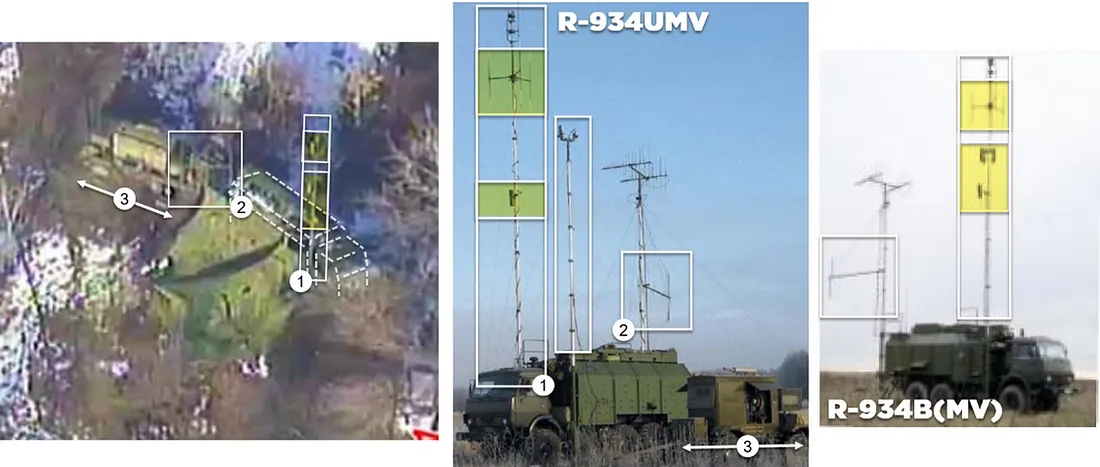
A Russian MoD press release corroborates this pairing, in which they report R-330Zh’s and R-934s working together in anti-UAV operations:
В свою очередь, экипажи комплексов РЭБ Р-934БМВ и Р-330Ж «Житель» обеспечили перехват, подавление каналов управления и передачи мультимедийной информации БЛА
(Translation: “For their part, crews of the EW systems R-934BMV and R-330Zh ‘Zhitel’ ensured the interception and suppression of control channels for the UAV’s multimedia information channels”).
Some of the drone imagery in Shtirlits’s Facebook post showed artillery impacts that the drone allegedly directed against the Russian vehicles. The DFRLab was unable to geolocate the impacts conclusively, but a follow-up visit on March 28 by the OSCE SMM confirmed fresh impacts at the locations of the Russian EW vehicles. It is these impacts, confirmed on March 28 by the OSCE SMM and visible in Shtirlits’s imagery, that allowed for confirmation that his footage was taken prior to that date.
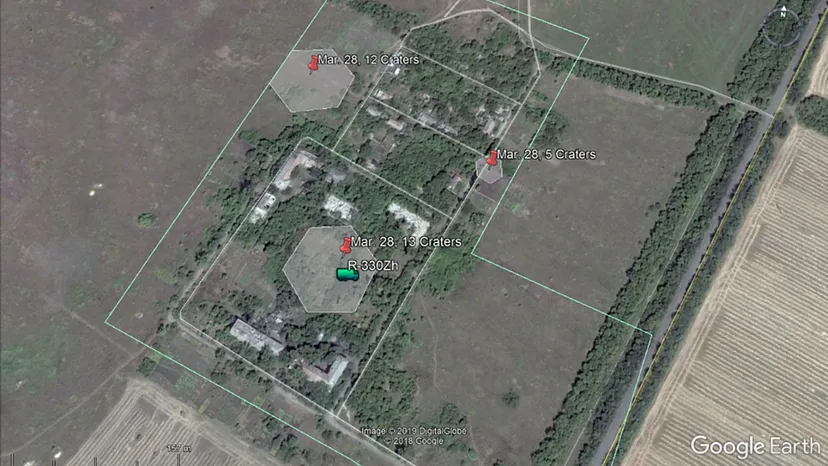
On its March 28 visit to Hlybokyi, the OSCE SMM noted three different impact areas, as illustrated above. The description of the area with the most craters was consistent with where the location of the R-330Zh as observed in Hlybokyi. The OSCE also observed a smashed windshield in the area that it assessed to be from “a possible heavy utility truck (KamAZ variant).” This would be consistent with the types of chasses on the EW vehicles observed in Shtirlits’s drone imagery, suggesting that the vehicles took damage during the shelling.
Previous Sightings
At this point in the conflict, the R-330Zh has been recorded extensively as one of the main systems deployed for electronic warfare in eastern Ukraine. The DFRLab compiled an interactive map with every publicly recorded R-330Zh sighting to date.
As documented in the above map, the R-330Zh has operated in virtually every corner of separatist-held Ukraine, commonly alongside other EW vehicles, some of which have not yet been identified.
The earliest publicly documented sighting of the R-330Zh was in an Informnapalm article that discovered map data on an R-330Zh denoting a presence in the eastern Ukrainian city of Horlivka. The exact location of this system was visible in satellite imagery from February 2015, and the article laid the groundwork for further discoveries of this system in the open-source information environment.
A later article discovered the same system in the Donetsk suburb of Makiivka through pictures posted to Russian social networking site VKontakte. Although this location was exposed in summer 2015 as a Russian EW operating site, satellite imagery from February 2016 showed that the system continued to appear at that location until that time.
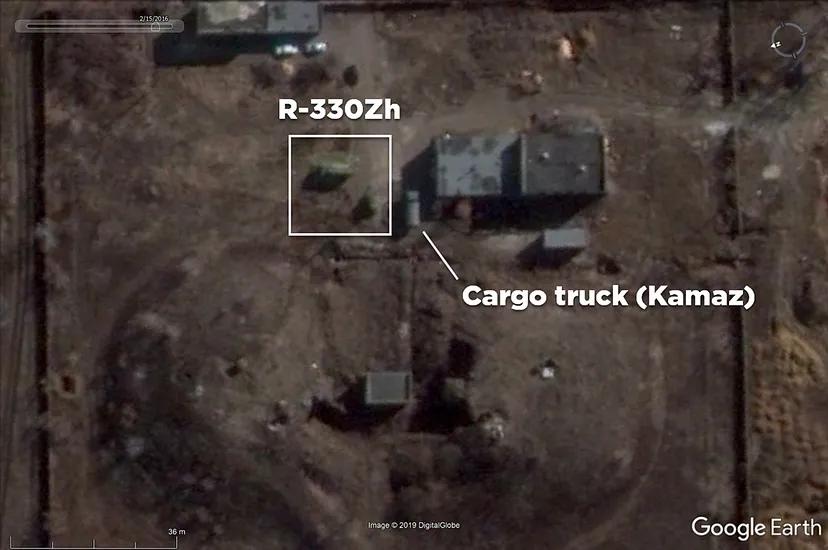
Subsequent drone imagery posted on Ukrainian journalist Yaroslav Krechko’s Facebook page on April 14, 2016, showed the system’s deployment to that location more clearly.
Meanwhile, OSCE SMM reporting from elsewhere in the Donbas region — the southern Donetsk Oblast — mentioned spotting this system around the same time. On August 15, 2015, an OSCE drone spotted an R-330Zh in the town of Michurine, about 54 km northeast of Mariupol and less than 10 km from the front lines.
While unavailable at the time, subsequently released satellite imagery on Google Earth showed the system in its operating position just west of Michurine. The position was an old disused water reservoir, a common terrain feature for deployment of these systems, possibly because of the cover and concealment that they offer. The system was intermittently visible in satellite imagery from August 10, 2015, until December 16, 2015, and, judging by tire marks visible in the imagery, appeared to have ceased operating in that location by the following summer.
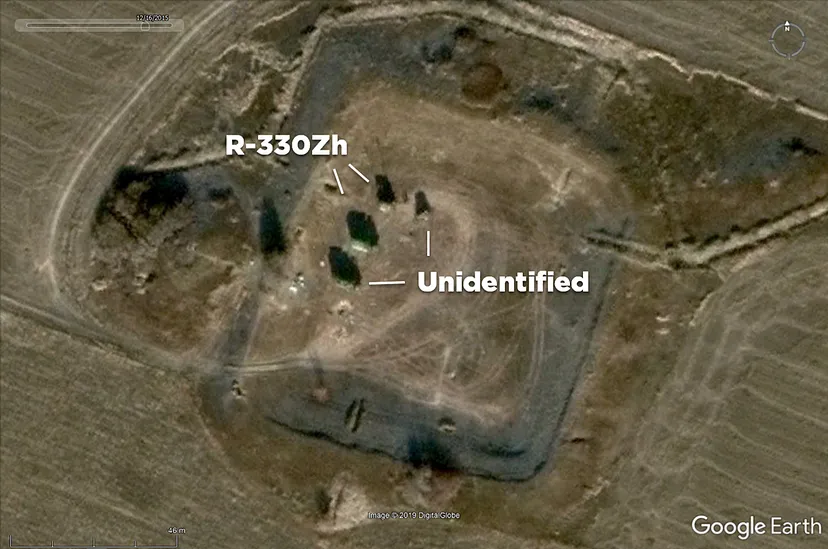
Of the above imagery showing the R-330Zh at this location, the December 2015 imagery showed the antennae on the systems most clearly. A second system was present alongside the R-330Zh but could not be identified from the satellite imagery alone and appeared to differ between the December and August imagery.
In October 2015, the UK delegation to the OSCE posted drone imagery on Twitter of another position west of Telmanove and a few kilometers south of the above position.

The system was visible at this location on Google satellite imagery on August 26, 2015, but not on August 10 like the previously observed system outside nearby Michurine. This suggested that this system and the one located near Michurine on August 10 were likely the same vehicles observed at different times. Both positions appeared to fall into disuse by summer 2016.
In a report by InformNapalm in late 2017, UAV footage showed an R-330Zh next to an unidentified vehicle that most closely resembled an R-934 variant, as identified in the Ukrainian MoD presentation. This time, the R-330Zh was located in the settlement of Zemlyane, a few kilometers northwest of Luhansk.
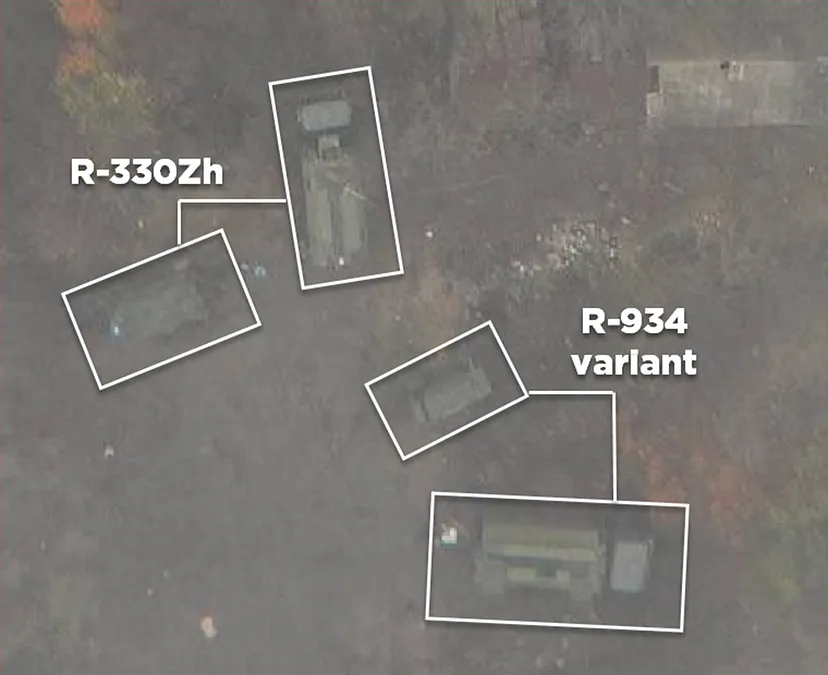
Sightings like these persisted throughout 2017, covering every sector of the conflict zone, albeit with a heavier recorded presence in the North.
The R-330Zh has been a staple in Russian anti-UAV operations in eastern Ukraine since 2015 and is now making its return to public view after not being publicly located for all of 2018. Although the R-330Zh at times has been caught operating alone, it is often spotted alongside other EW systems, possibly as part of mobile EW groups to counter drones.
Recent drone imagery posted by Shtirlits, along with OSCE SMM follow-up reporting, showed increased Ukrainian resilience to counter these Russian EW systems. The R-330Zh has been detected by Ukrainian and OSCE drones in the past, but, as the impact craters confirmed by the OSCE SMM on March 28 evince, this marked the first documented incident where Ukrainians were able to direct artillery fire against one, a combat mission that very likely included the direct involvement of drones. Clause 10 of the Minsk II agreements clearly stipulates the withdrawal of all foreign armed formations and military equipment, and this uptick is further evidence of Russia’s disregard for the agreements. The reason for the surge in public sightings is unclear, though they may suggest ongoing equipment tests or a desire to learn real-world lessons from more advanced adversary drones than those Russia encounters in Syria.
The DFRLab will continue to report on the presence and operation of Russian EW systems in eastern Ukraine.
Follow the latest Minsk II violations via the @DFRLab’s #MinskMonitor.
For more in-depth analysis from our regional experts follow the AtlanticCouncil’s Dinu Patriciu Eurasia Center. Or subscribe to UkraineAlert.
Follow along for more in-depth analysis from our #DigitalSherlocks.

